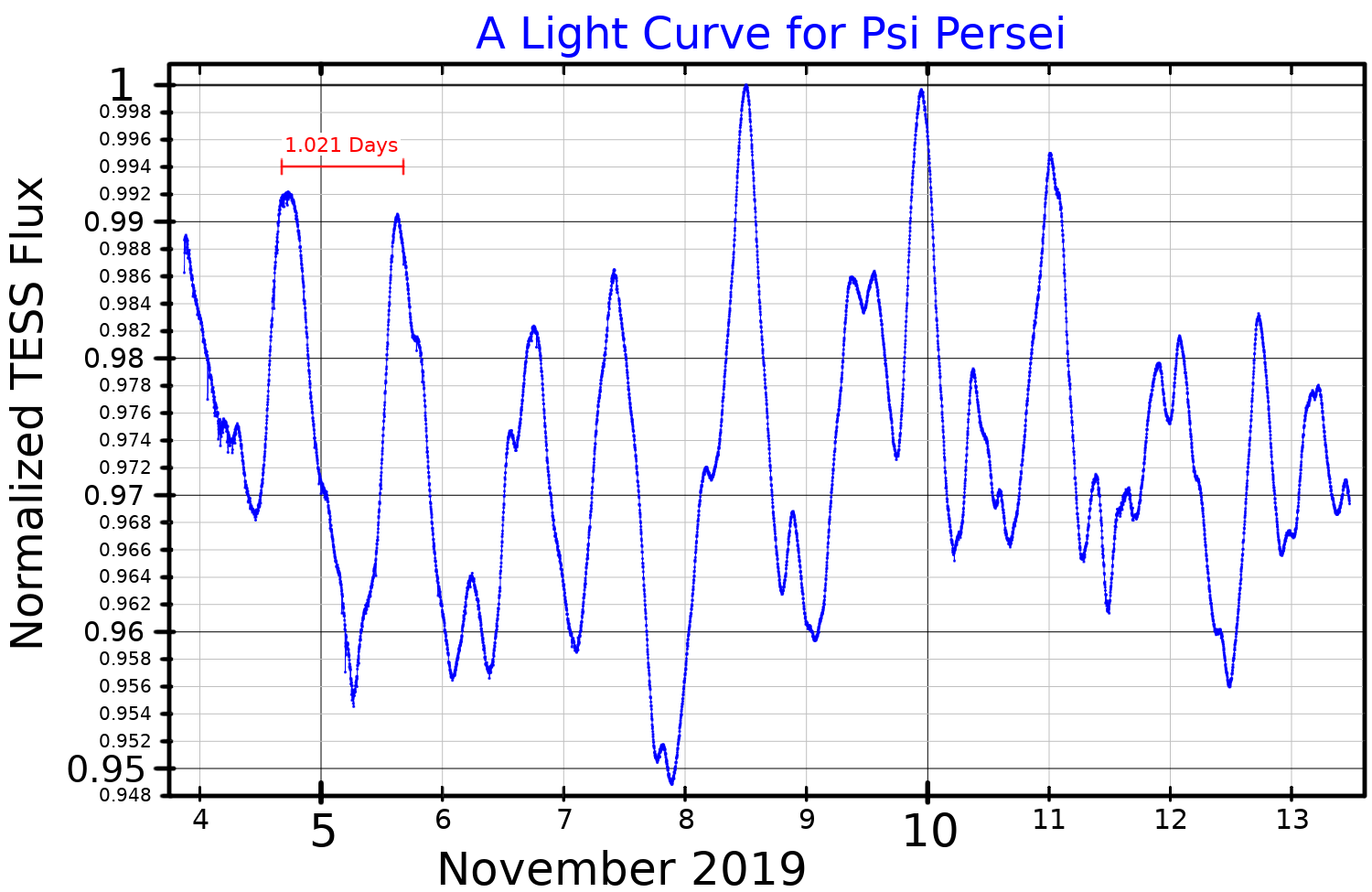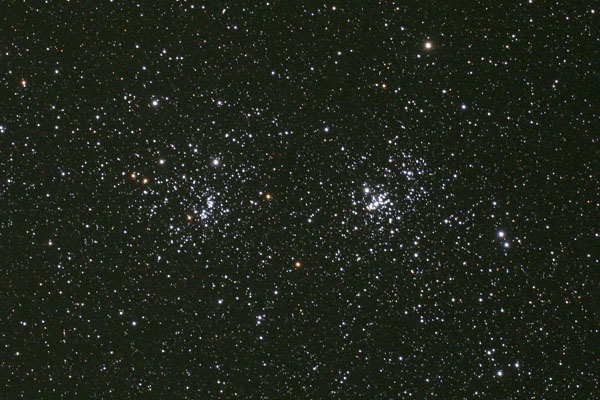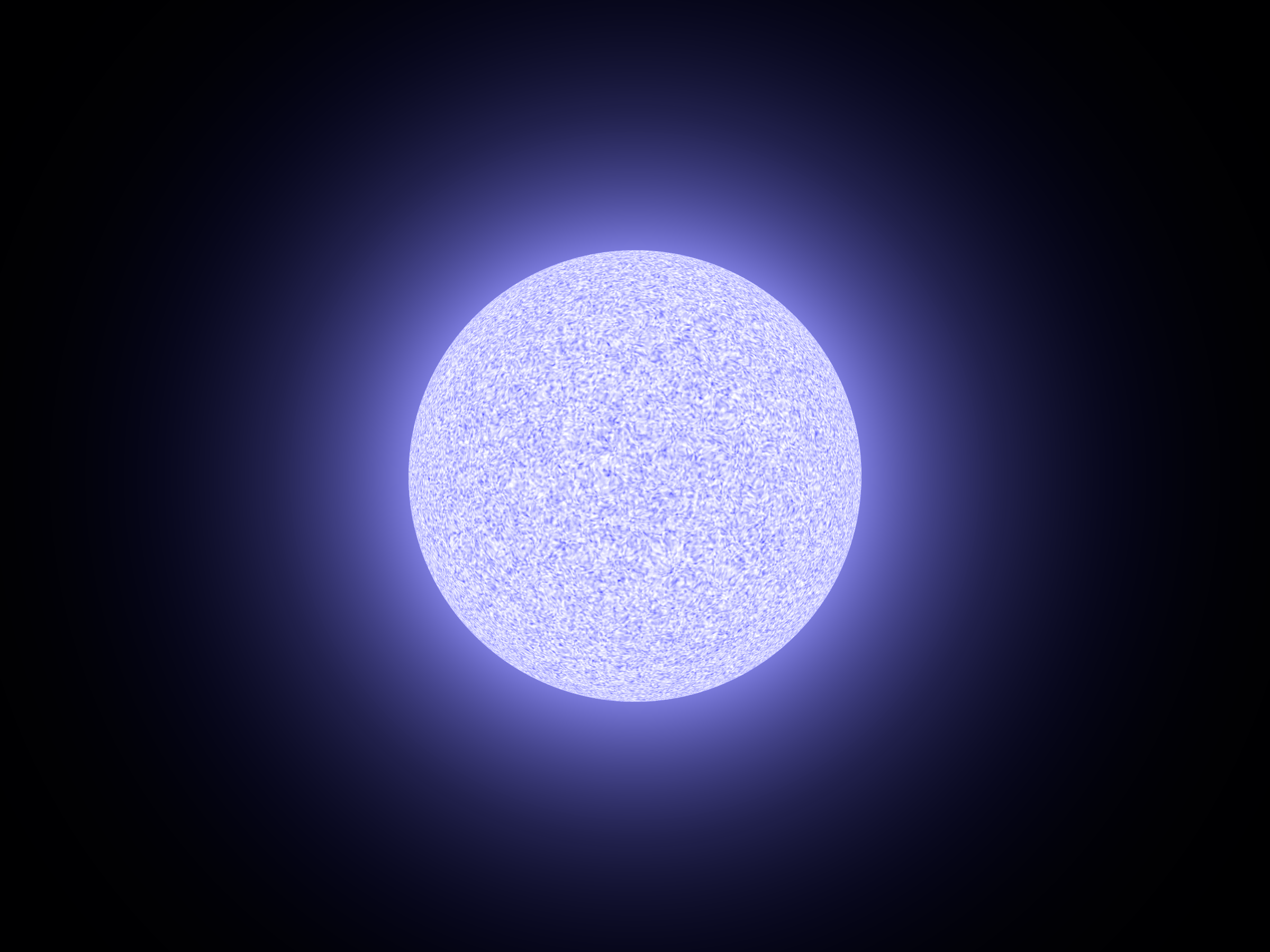|
ψ Persei
Psi Persei (Psi Per, ψ Persei, ψ Per) is a single Be star in the northern constellation of Perseus. It has an apparent visual magnitude of about 4.2, so it is visible to the naked eye at night under suitably dark skies. Based on parallax measurements, it is located at a distance of roughly from the Earth. Properties This star has a stellar classification of B5Ve, which indicates it is a B-type main sequence star that is generating energy at its core through the nuclear fusion of hydrogen. It is a shell star with a circumstellar disc of gas surrounding the equator and extending out to about 11 times the radius of the star. As a result of this disc, the spectrum of this star shows emission lines (as indicated by the 'e' in the stellar class) and its magnitude varies over a period 1.021 days. The General Catalog of Variable Stars classifies Psi Persei as a gamma Cassiopeiae variable star, whose visual band brightness varies from magnitude 4.17 to 4. ... [...More Info...] [...Related Items...] OR: [Wikipedia] [Google] [Baidu] |
Perseus (constellation)
Perseus is a constellation in the Northern celestial hemisphere, northern sky, named after the Greek mythology, Greek mythological hero Perseus. It is one of the 48 ancient constellations listed by the 2nd-century astronomer Ptolemy, and among the IAU designated constellations, 88 modern constellations defined by the International Astronomical Union (IAU). It is located near several other constellations named after ancient Greek legends surrounding Perseus, including Andromeda (constellation), Andromeda to the west and Cassiopeia (constellation), Cassiopeia to the north. Perseus is also bordered by Aries (constellation), Aries and Taurus (constellation), Taurus to the south, Auriga (constellation), Auriga to the east, Camelopardalis to the north, and Triangulum to the west. Some Celestial cartography, star atlases during the early 19th century also depicted Perseus holding the disembodied head of Medusa, whose Asterism (astronomy), asterism was named together as ''Perseus et Capu ... [...More Info...] [...Related Items...] OR: [Wikipedia] [Google] [Baidu] |
B-type Main Sequence Star
A B-type main-sequence star (B V) is a main-sequence (hydrogen-burning) star of spectral type B and luminosity class V. These stars have from 2 to 16 times the mass of the Sun and surface temperatures between 10,000 and 30,000 K. B-type stars are extremely luminous and blue. Their spectra have strong neutral helium absorption lines, which are most prominent at the B2 subclass, and moderately strong hydrogen lines. Examples include Regulus, Algol A and Acrux. History This class of stars was introduced with the Harvard sequence of stellar spectra and published in the ''Revised Harvard photometry'' catalogue. The definition of type B-type stars was the presence of non-ionized helium lines with the absence of singly ionized helium in the blue-violet portion of the spectrum. All of the spectral classes, including the B type, were subdivided with a numerical suffix that indicated the degree to which they approached the next classification. Thus B2 is 1/5 of the way from type B (or ... [...More Info...] [...Related Items...] OR: [Wikipedia] [Google] [Baidu] |
APOGEE
An apsis (; ) is the farthest or nearest point in the orbit of a planetary body about its primary body. The line of apsides (also called apse line, or major axis of the orbit) is the line connecting the two extreme values. Apsides pertaining to orbits around different bodies have distinct names to differentiate themselves from other apsides. Apsides pertaining to geocentric orbits, orbits around the Earth, are at the farthest point called the ''apogee'', and at the nearest point the ''perigee'', like with orbits of satellites and the Moon around Earth. Apsides pertaining to orbits around the Sun are named ''aphelion'' for the farthest and ''perihelion'' for the nearest point in a heliocentric orbit. Earth's two apsides are the farthest point, ''aphelion'', and the nearest point, ''perihelion'', of its orbit around the host Sun. The terms ''aphelion'' and ''perihelion'' apply in the same way to the orbits of Jupiter and the other planets, the comets, and the asteroids of t ... [...More Info...] [...Related Items...] OR: [Wikipedia] [Google] [Baidu] |
GALAH
The galah (; ''Eolophus roseicapilla''), less commonly known as the pink and grey cockatoo or rose-breasted cockatoo, is an Australian species of cockatoo and the only member of the genus ''Eolophus''. The galah is adapted to a wide variety of modified and unmodified habitats and is one of Australia's most abundant and widespread bird species. The species is endemic to mainland Australia. It was introduced species, introduced to Tasmania, where it is now widespread, in the mid-19th century and much more recently to New Zealand. Etymology The term galah is derived from ''gilaa'', a word from the Yuwaalaraay and neighbouring Australian Aboriginal languages, Aboriginal languages spoken in north-western New South Wales. Description The galah is about in length, and weighs . It has a pale silver to grey back, a pale grey rump, a pink face and breast, and a light pink mobile Crest (feathers), crest. It has a bone-coloured beak, and the bare skin of the eye ring is caruncle (bird an ... [...More Info...] [...Related Items...] OR: [Wikipedia] [Google] [Baidu] |
Proper Motion
Proper motion is the astrometric measure of changes in the apparent places of stars or other celestial objects as they move relative to the center of mass of the Solar System. It is measured relative to the distant stars or a stable reference such as the International Celestial Reference Frame (ICRF). Patterns in proper motion reveal larger structures like stellar streams, the general rotation of the Milky Way disk, and the random motions of stars in the Galactic halo. The components for proper motion in the equatorial coordinate system (of a given epoch, often J2000.0) are given in the direction of right ascension (''μ''α) and of declination (''μ''δ). Their combined value is computed as the ''total proper motion'' (''μ''). It has dimensions of angle per time, typically arcseconds per year or milliarcseconds per year. Knowledge of the proper motion, distance, and radial velocity allows calculations of an object's motion from the Solar System's frame of reference an ... [...More Info...] [...Related Items...] OR: [Wikipedia] [Google] [Baidu] |
Alpha Persei Cluster
The Alpha Persei Cluster, also known as Melotte 20 or Collinder 39, is an open cluster of stars in the northern constellation of Perseus (constellation), Perseus. To the naked eye, the cluster consists of several blue-hued spectral type B stars. The most luminous member is the ~2nd magnitude Yellow supergiant, yellow supergiant star, supergiant Mirfak, also known as Alpha Persei. Bright members also include Delta Persei, Delta, Sigma Persei, Sigma, Psi Persei, Psi, 29, 30, 34, and 48 Persei. The Hipparcos satellite and infrared color-magnitude diagram fitting have been used to establish a distance to the cluster of ~. The distance established via the independent analyses agree, thereby making the cluster an important rung on the cosmic distance ladder. As seen from the Earth, the Extinction (astronomy), extinction of the cluster due to interstellar dust is around 0.30. The cluster is centered to the northeast of Alpha Persei. It has a core radius of , a half-mass radius of , and a ... [...More Info...] [...Related Items...] OR: [Wikipedia] [Google] [Baidu] |
Oblate
In Christianity (specifically the Roman Catholic, Orthodox, Lutheran, Anglican and Methodist traditions), an oblate is a person associated with a Benedictine monastery or convent who is specifically dedicated to God and service. Oblates are individuals, either laity or clergy, normally living in general society, who, while not professed monks or nuns, have individually joined themselves to a Benedictine monastic community associated with a certain Christian denomination, such as the Catholic Church or Lutheran Church. Individuals become oblates by undergoing an investiture in which they resolve to follow the Rule of Saint Benedict in their private lives. The Divine Office (canonical hours) is a focus of Benedictines and oblates strive to pray these individually or with others, including with monastics throughout the day in person, or live-streamed; this is normatively prayed seven times a day (cf. ). They additionally seek to daily read the Bible through the monastic method of ... [...More Info...] [...Related Items...] OR: [Wikipedia] [Google] [Baidu] |
Solar Mass
The solar mass () is a frequently used unit of mass in astronomy, equal to approximately . It is approximately equal to the mass of the Sun. It is often used to indicate the masses of other stars, as well as stellar clusters, nebulae, galaxies and black holes. More precisely, the mass of the Sun is The solar mass is about times the mass of Earth (), or times the mass of Jupiter (). History of measurement The value of the gravitational constant was first derived from measurements that were made by Henry Cavendish in 1798 with a torsion balance. The value he obtained differs by only 1% from the modern value, but was not as precise. The diurnal parallax of the Sun was accurately measured during the transits of Venus in 1761 and 1769, yielding a value of (9 arcseconds, compared to the present value of ). From the value of the diurnal parallax, one can determine the distance to the Sun from the geometry of Earth. The first known estimate of the solar mass was by ... [...More Info...] [...Related Items...] OR: [Wikipedia] [Google] [Baidu] |
Azimuthal
An azimuth (; from ) is the horizontal angle from a cardinal direction, most commonly north, in a local or observer-centric spherical coordinate system. Mathematically, the relative position vector from an observer (origin) to a point of interest is projected perpendicularly onto a reference plane (the horizontal plane); the angle between the projected vector and a reference vector on the reference plane is called the azimuth. When used as a celestial coordinate, the azimuth is the horizontal direction of a star or other astronomical object in the sky. The star is the point of interest, the reference plane is the local area (e.g. a circular area with a 5 km radius at sea level) around an observer on Earth's surface, and the reference vector points to true north. The azimuth is the angle between the north vector and the star's vector on the horizontal plane. Azimuth is usually measured in degrees (°), in the positive range 0° to 360° or in the signed range -180° to ... [...More Info...] [...Related Items...] OR: [Wikipedia] [Google] [Baidu] |
Stellar Rotation
Stellar rotation is the angular motion of a star about its axis. The rate of rotation can be measured from the spectrum of the star, or by timing the movements of active features on the surface. The rotation of a star produces an equatorial bulge due to centrifugal force. As stars are not solid bodies, they can also undergo differential rotation. Thus the equator of the star can rotate at a different angular velocity than the higher latitudes. These differences in the rate of rotation within a star may have a significant role in the generation of a stellar magnetic field. In its turn, the magnetic field of a star interacts with the stellar wind. As the wind moves away from the star its angular speed decreases. The magnetic field of the star interacts with the wind, which applies a drag to the stellar rotation. As a result, angular momentum is transferred from the star to the wind, and over time this gradually slows the star's rate of rotation. Measurement Unless a star ... [...More Info...] [...Related Items...] OR: [Wikipedia] [Google] [Baidu] |
Photometric System
In astronomy, a photometric system is a set of well-defined passbands (or optical filters), with a known sensitivity to incident radiation. The sensitivity usually depends on the optical system, detectors and filters used. For each photometric system a set of primary standard stars is provided. A commonly adopted standardized photometric system is the Johnson-Morgan or UBV photometric system (1953). At present, there are more than 200 photometric systems. Photometric systems are usually characterized according to the widths of their passbands: * broadband (passbands wider than 30 nm, of which the most widely used is Johnson-Morgan UBV system) * intermediate band (passbands between 10 and 30 nm wide) * narrow band (passbands less than 10 nm wide) Photometric letters Each letter designates a section of light of the electromagnetic spectrum; these cover well the consecutive major groups, near-ultraviolet (NUV), visible light (centered on the V band), near-infra ... [...More Info...] [...Related Items...] OR: [Wikipedia] [Google] [Baidu] |
General Catalog Of Variable Stars
A general officer is an officer of high rank in the armies, and in some nations' air and space forces, marines or naval infantry. In some usages, the term "general officer" refers to a rank above colonel."general, adj. and n.". OED Online. March 2021. Oxford University Press. https://www.oed.com/view/Entry/77489?rskey=dCKrg4&result=1 (accessed May 11, 2021) The adjective ''general'' had been affixed to officer designations since the late medieval period to indicate relative superiority or an extended jurisdiction. French Revolutionary system Arab system Other variations Other nomenclatures for general officers include the titles and ranks: * Adjutant general * Commandant-general * Inspector general * General-in-chief * General of the Air Force (USAF only) * General of the Armies of the United States (of America), a title created for General John J. Pershing, and subsequently granted posthumously to George Washington and Ulysses S. Grant * (" general ... [...More Info...] [...Related Items...] OR: [Wikipedia] [Google] [Baidu] |




